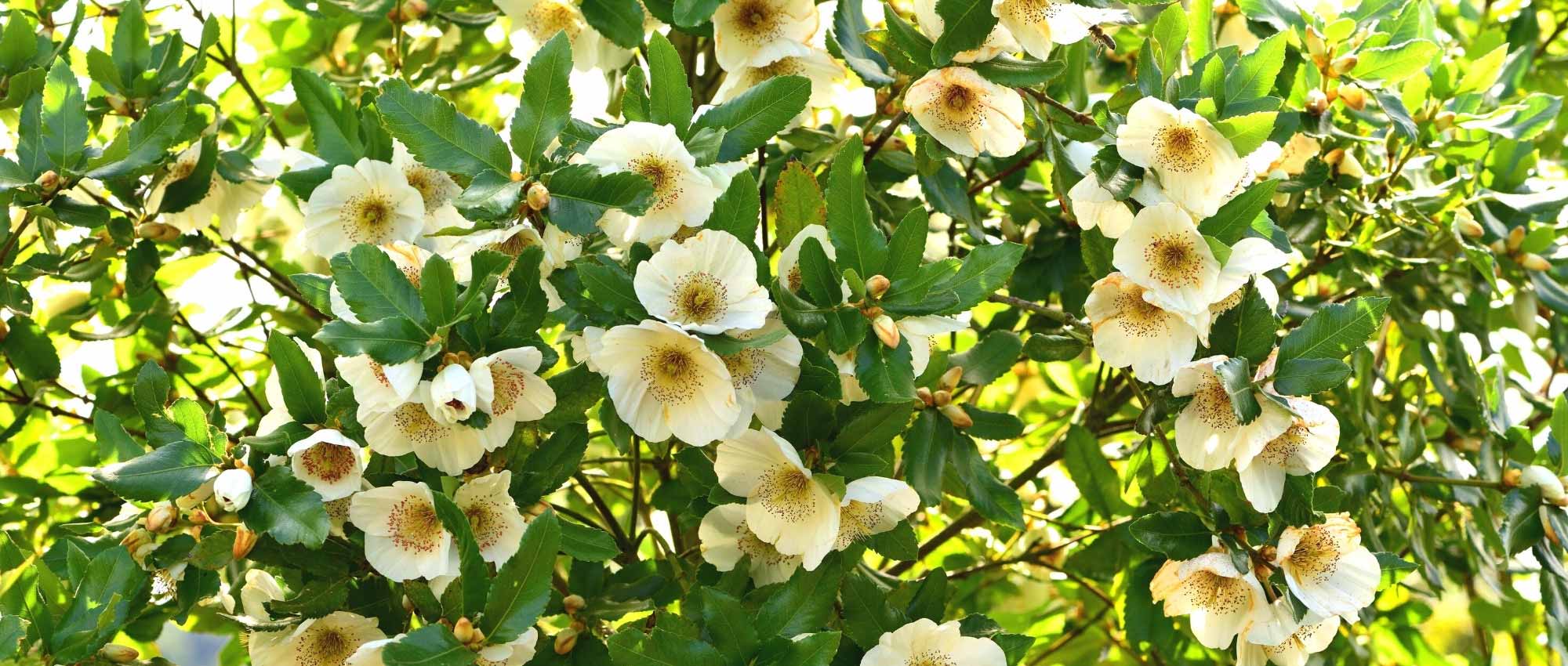
Eucryphia: planting, growing, and caring for
Contents
Eucryphia in a nutshell
- Eucryphia are trees and bushes native to Australia and Chile, still relatively unknown in France
- They have a columnar habit and generally evergreen foliage
- They produce beautiful white or pink flowers in summer, pleasantly scented
- They are particularly suited to the mild regions of the Atlantic coast, especially Brittany
- Not very hardy, they thrive in mild, humid climates and prefer cool, non-calcareous soil
A word from our expert
Originating from Australia, Tasmania, and Chile, Eucryphia are trees and bushes that are still relatively unknown, but offer a spectacular flowering in summer. They produce pleasantly scented white or pink flowers, consisting of four petals and a cluster of central stamens. Their very simple and elegant style is reminiscent of the flowering of wild roses. Their foliage is quite ordinary, generally made up of entire, dark green, glossy leaves; however, some varieties stand out with original foliage: Eucryphia ‘Gilt Edge’, for example, features beautifully variegated yellow leaves, and Eucryphia moorei has finely cut leaves.
Eucryphia are demanding bushes, requiring specific conditions to thrive: mild and rather humid climate, non-calcareous soil… however, if these conditions are met, Eucryphia rewards us with the stunning spectacle of its flowering! Eucryphia are not very hardy (although the species Eucryphia glutinosa can withstand temperatures down to -15 °C), and are particularly suited to the mild climate of the Atlantic coast, especially in Brittany and Normandy. Discover all our tips for successfully growing Eucryphia in your garden!
Botany
Botanical data
- Latin name Eucryphia sp.
- Family Cunoniaceae
- Common name Eucryphia
- Flowering between July and September
- Height 3 to 10 m
- Exposure full sun or partial shade
- Soil type cool and draining, non-calcareous
- Hardiness variable, but the hardiest can withstand between -10 °C and -15 °C
Eucryphia comprises 11 species of trees and bushes native to the southern hemisphere, particularly from the temperate regions of Australia, Tasmania, and Chile. They thrive in mild, humid oceanic climates and are not very hardy (the Eucryphia glutinosa is the most cold-resistant, capable of withstanding temperatures down to -15 °C). They primarily grow in rainforests and on acidic soil.
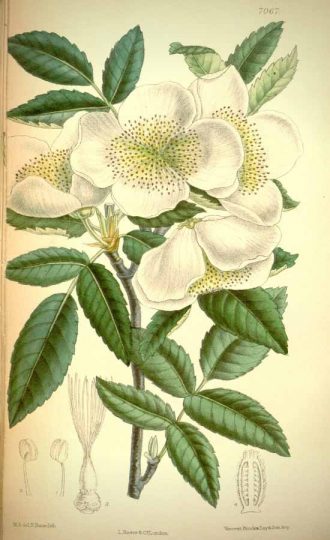
Eucryphia cordifolia: Botanical illustration
Eucryphia belong to the family Cunoniaceae, which includes little-known plants in France that are rarely cultivated, mainly originating from the southern hemisphere, particularly Chile and Australia. They were previously classified in the family Eucryphiaceae.
The name Eucryphia comes from the Greek Eu: “well” and Kryphios: “hidden”, referring to the sepals that meet at the top of the flower buds before they open. The species name of Eucryphia lucida alludes to its glossy leaves, while E. glutinosa refers to the sticky appearance of its young shoots, E. cordifolia denotes the heart-shaped leaves, and Eucryphia moorei is named in honour of Charles Moore, a 19th-century Scottish botanist who was director of the Sydney botanical garden (the E. moorei is native to Australia).
Eucryphia can reach heights of between 3 and 10 metres, depending on the species and growing conditions. They typically have a columnar habit, with a tall, narrow crown.
In summer, between July and September, Eucryphia display their splendid fragrant flowering, rewarding the gardener who takes the effort to cultivate them. They produce very beautiful white or pale pink flowers, inserted at the axil of the leaves, either solitary or in pairs. Their flowers are simple, cup-shaped and more or less flattened, composed of four large petals surrounding a bouquet of stamens and styles. They somewhat resemble the flowers of wild roses. The flowers measure between 2 and 6 cm in diameter, except for Eucryphia milliganii, which has much smaller flowers, measuring 1 to 2 cm in diameter.
The flowers are generally fragrant, with a scent reminiscent of honey and linden. They are melliferous, attracting bees and many pollinating insects. The nectar of Eucryphia lucida in Tasmania and that of Eucryphia cordifolia in Chile both produce a renowned honey, with a fruity and exotic flavour, known respectively as Leatherwood Honey and Ulmo Honey.

The flowering of Eucryphia glutinosa, Eucryphia x nymansensis (photo Ashley Balsam) and Eucryphia cordifolia
Eucryphia generally have dark green, glossy leaves on the upper side, glaucous underneath, except for the Eucryphia lucida ‘Gilt Edge’, which is distinguished by its beautifully variegated yellow foliage. The leaves of Eucryphia are elliptical to oblong, thick and leathery, measuring between 3 and 6 cm long. The edge of the lamina is dentate or smooth depending on the variety. They are opposite, inserted in pairs, one facing the other on the branches. The leaves are generally simple, entire, but can also be divided, as seen in the Eucryphia moorei, which has very beautiful foliage divided into 5 to 13 leaflets.
Eucryphia are evergreen to semi-evergreen (losing their leaves in harsh winters), except for Eucryphia glutinosa, which is deciduous. Its foliage takes on beautiful orange-red hues in autumn before falling.
After flowering, Eucryphia forms elongated, woody capsules, measuring 1 to 1.5 cm long, containing several winged seeds. These can remain on the tree for up to a year before opening to release the seeds. They are dispersed by the wind, their wings allowing them to fly, similar to the samaras of maples.

The foliage of Eucryphia glutinosa and Eucryphia moorei (photos: Krzysztof Golik), and the fruits of Eucryphia cordifolia (photo: Dick Culber)
Read also
Plant young ericaceous plantsThe main varieties of Eucryphia
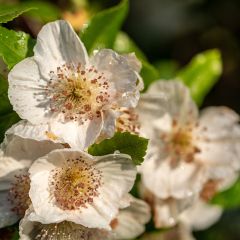
Eucryphia x intermedia Rostrevor
- Flowering time September, October
- Height at maturity 6,50 m
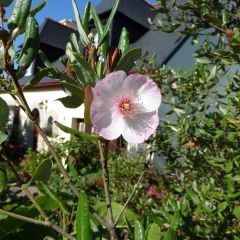
Eucryphia lucida Pink cloud
- Flowering time August to October
- Height at maturity 4 m
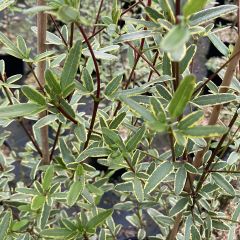
Eucryphia lucida Gilt Edge
- Flowering time September, October
- Height at maturity 4 m
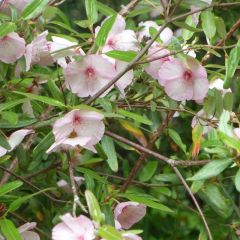
Eucryphia lucida Ballerina
- Flowering time September, October
- Height at maturity 6 m
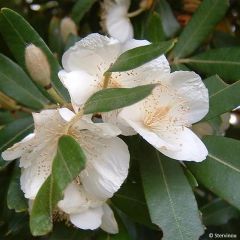
Eucryphia moorei
- Flowering time August, September
- Height at maturity 8 m
Discover other Eucryphia
View all →Available in 1 sizes
Available in 1 sizes
Available in 1 sizes
Available in 1 sizes
Available in 1 sizes
Planting
Where to Plant Eucryphia?
Eucryphia is not very hardy: it needs a mild climate, where the risk of frost is low, but also humid. In France, it thrives particularly in Brittany and Normandy, near the English Channel or along the Atlantic coast. You can also place it near a pond to benefit from the ambient moisture. Eucryphia are not really suited to a Mediterranean climate, as it is too hot and dry for them in summer.
Eucryphia prefers light, humus-bearing, fertile soils. It does not like drought: it needs fresh but well-draining soil, without excess moisture in winter. Eucryphia cordifolia and Eucryphia x nymansensis are the only ones that tolerate limestone; other species prefer rather acidic soil: do not hesitate to add heather soil at the time of planting.
Eucryphia will thrive in full sun or partial shade. Generally, it likes to have its roots in the shade, cool, and its head in the sun, which will encourage generous flowering. Be careful to avoid hot and dry situations, and place it, if possible, sheltered from the wind, protected by a hedge, walls, or a garden shed…
Choose its location carefully as Eucryphia does not like to be transplanted (its roots are fragile). It is not suitable for pot cultivation.
When to Plant?
We recommend planting Eucryphia in spring, around May, after the last frosts. If you live in a region with a mild climate, where the risk of frost is low, you can also plant it in autumn (September-October).
How to Plant?
- Start by placing the root ball in a basin of water to rehydrate it.
- Dig a large planting hole, two to three times the size of the root ball.
- Add heather soil and a bit of compost, mixing it with the planting soil. If your soil tends to retain water, you can also add some coarse sand to improve drainage.
- Plant the Eucryphia well in the centre, ensuring it is upright.
- Replace soil all around, without burying the collar, then lightly firm it down.
- Do not hesitate to install a stake to keep the Eucryphia upright.
- You can also create a watering basin to facilitate water infiltration at its roots.
- Water generously.

Eucryphia milliganii, a lovely bush distinguished by its small oblong leaves and tiny white flowers
Read also
7 trees with white flowersEntretien
Once established, Eucryphia requires little maintenance, as it is resistant to diseases and pests, and does not require pruning. However, you may choose to prune it if necessary to remove dead, damaged, or poorly placed branches. Intervene after flowering.
Eucryphia does not tolerate drought: it needs the soil to remain relatively moist in summer, so do not hesitate to water regularly, preferably with rainwater. We recommend mulching Eucryphia by placing a layer of pine bark mulch at its base. This will help keep the soil cool for longer. You can also plant groundcover plants around it, which will help retain soil moisture.
Each year, you can top-dress with heather soil and a bit of compost, which you should incorporate into the soil with light raking.
During the first few years, do not hesitate to protect Eucryphia during severe frosts by covering it with fleece.
Multiplication
It is possible to propagate Eucryphia by sowing; however, we recommend propagation by cuttings, as this technique will ensure a better success rate.
Propagation by Cuttings
Eucryphia can be propagated by taking semi-woody stem cuttings in summer, around July.
- Take a healthy, semi-woody shoot (soft at the tip and lignified at the base), 8 to 10 cm long, cutting just below a node (the point where leaves attach to the stem).
- Remove the leaves from the lower part, leaving only 2 or 3 at the tip of the shoot. Also, remove any flowers or flower buds if present.
- Dip the base of the cutting in plant hormone.
- Fill a pot with light, well-draining compost, then water.
- Plant the cutting in the substrate, then firm the soil around it to eliminate air bubbles and ensure good contact between the shoot and the substrate.
- Place the pot in a sheltered location, in a bright spot, away from direct sunlight.
Eucryphia cuttings can take between one to six months to root. Ensure the soil remains moist until they establish by watering regularly. Keep the young plants sheltered over winter, then repot them in larger pots the following spring to support their growth.
For more information, feel free to consult our advice sheet on propagation by cuttings.
Association
As it thrives in acidic, cool, and well-draining soil, and appreciates having its roots in the shade, do not hesitate to pair Eucryphia with heather soil shrubs, such as rhododendrons and azaleas, Pieris japonica, Daphnes, Japanese maples, and hydrangeas. Discover the Crinodendron hookerianum, charmingly nicknamed Lantern Tree, a shrub that offers lovely red bells from May to September. Also consider the azaleas from the ‘Encore’ series, which bloom two to three times a year in successive waves from spring to autumn. Alongside them, you can integrate a Japanese maple, for example, the variety ‘Summer Gold’, whose golden foliage will bring plenty of brightness!
Find our entire range of heather soil shrubs by clicking here.
To maintain a cool and shaded soil while highlighting its silhouette, you can pair Eucryphia with low-growing, spreading groundcover shrubs. Consider, for example, the ‘Pink Cascade’ azalea, which does not exceed 50 cm in height, Cotoneaster dammeri, heathers, and the creeping spindle tree Euonymus fortunei ‘Radicans’.
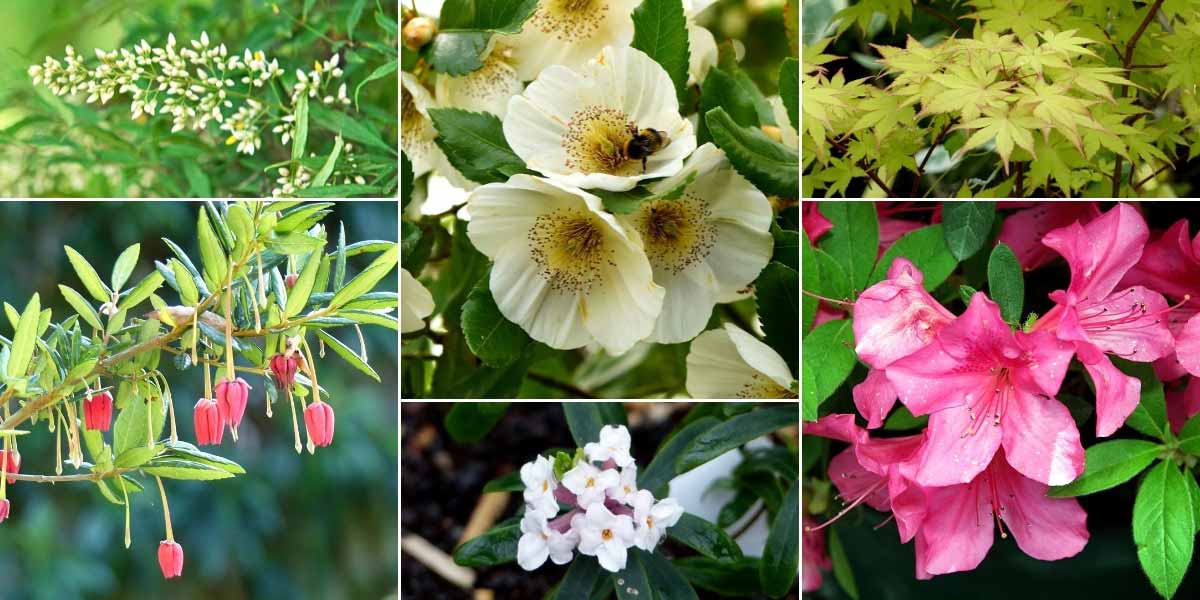
Nandina domestica, Eucryphia x nymansensis ‘Nymansay’, Acer palmatum ‘Summer Gold’, Crinodendron hookerianum, Daphne ‘Eternal Fragrance’ and Azalea ‘Encore Sangria’ (photo David J. Stang)
→ Discover more pairing ideas with Eucryphia in our advice sheet!
Also to read
- Find our entire range of Eucryphia by clicking here
- Our article “5 things to know to succeed with heather soil bushes”
- To pair with Eucryphia, discover our entire range of heather soil bushes
- Subscribe!
- Contents




































Comments